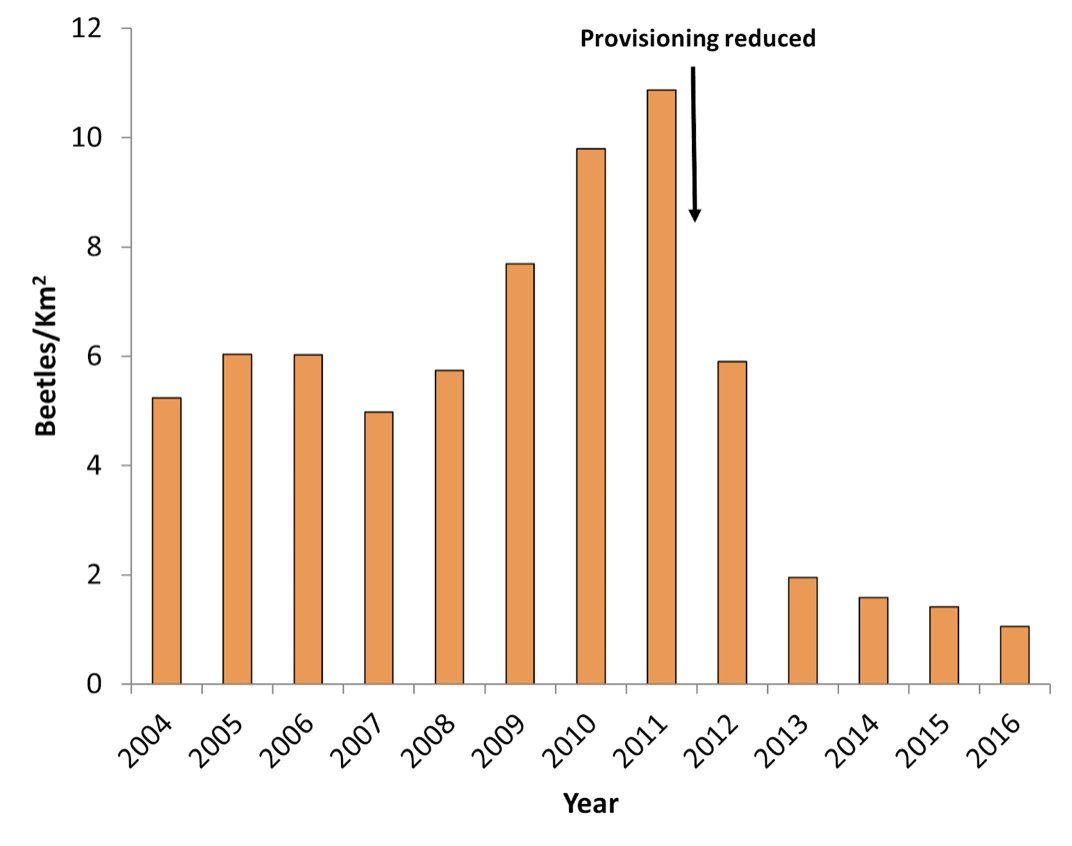RESEARCH – ecology & biodiversity
American Burying Beetle Research
In the past, the American Burying Beetle (ABB) was widespread across eastern North America, including Nantucket, but it now only exists in a few isolated areas. It used to be one of the few insects on the Endangered Species List. The only naturally surviving population east of the Mississippi River is on Block Island, RI and Nantucket is now the second eastern population.
The ABB is a recycler in nature and it reproduces by finding and burying dead birds or mammals about the size of a small rat. It raises its young on this carcass underground in what we call a brood chamber. Check out this video to learn more about how researchers help the ABBs with this process: https://youtu.be/dfa1duORCf4
Since the first reintroduction in 1994 on Nantucket, the ABB population here has been through ups and downs. After 16 years of intensive work to increase the reintroduced population, six years of less intensive work resulted in a population decrease, indicating that the species is still dependent on human assistance for survival. This research was published in 2016.
This project has gone through phases:
- Reintroduce the zoo reared beetles (check out the zoo’s website to learn more about this!) and monitor how well they survive year to year.
- Expand the trapping and quail hand-outs to drastically increase the population. In this phase we tried to trap everywhere on the island where the beetle existed.
- Reduce the quail hand-outs and see if the beetles can survive on their own.
- Continue reintroductions after the population decreased.
The third phase started in 2011, when researchers stopped giving quail to all the beetles we caught. They limited the number to the first 25 pairs of male and female beetles captured. This was a reduction of about 75%! The drop in the number of beetles since 2011 suggests that the beetles cannot survive on their own in large numbers on Nantucket.
The amount of natural carrion is probably a major limiting factor for this species. It is thought that ABBs evolved with passenger pigeons which once numbered in the billions along the east coast but are now extinct (due to human hunting and habitat destruction).
Following the result of the previous phase, a second round of reintroductions began in 2018 with a goal to increase the population to a level that is easy to maintain and could potentially survive natural disasters. The Nantucket population is important because it provides a backup gene pool for the original population on Block Island.
Since 2007, trapping beetles became more complicated when crows learned how to steal the rotted chicken bait. In 2014, they were finally caught on camera!
Why should we care about this beetle?
There are several very good reasons:
- Practically, this beetle could produce chemical compounds that will save human lives in the future. It secretes fluids that kill bacteria and act as preservatives. This could be useful in space!
- Ethically, what right do we humans have to let a species go extinct due to our actions (reducing ABB habitat (open land) and resources (bird populations))? If this beetle disappears, we will never, ever be able to get it back.
- Ecologically, every loss of a species in an area or ecosystem weakens the overall food chain and brings it closer to collapse. If we keep losing species, eventually we will lose the things we depend on for survival. Healthy wetlands purify our waters, healthy oceans create our oxygen and absorb carbon dioxide, and healthy landscapes provide the pollinators that make our food possible. These could all disappear if we continue our cavalier attitudes about conservation.
In addition to strengthening Nantucket’s ecosystems, the reintroduced population of ABBs is a back up population. If a hurricane wipes out the Block Island population, the genetics of the east coast ABBs will still be preserved.
Publications
Mckenna-Foster, A., O'Dell, D., Sorrows, E., Laurenzano, J., & Perrotti, L. (2019). Vertebrate Scavenger Species Composition on Nantucket Island, Massachusetts and Implications for Nicrophorus americanus Olivier (American Burying Beetle) Reintroduction. Northeastern Naturalist, 26(1), 52-62. https://doi.org/10.1656/045.026.0106
Mckenna-Foster, A., Perrotti, L., Blyth, J., LoPresti, E., & Kennedy, R. S. (2016). Measuring success of a reintroduced population of the American burying beetle (Nicrophorus americanus Olivier) to Nantucket Island, MA. Journal of insect conservation, 20(5), 895-904. https://link.springer.com/article/10.1007/s10841-016-9926-2
The project is featured in a chapter in Jane Goodall’s book Hope for Animals and Their World and also appears in the book Golden Wings & Hairy Toes: Encounters with New England's Most Imperiled Wildlife.
In 2009, it was a front page Boston Globe article.
It also appeared in the IUCN’s 2011 Re-introduction Specialists Book.


